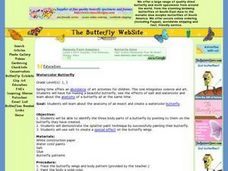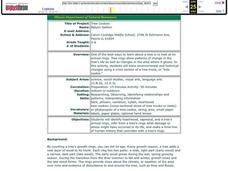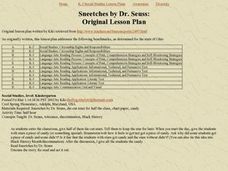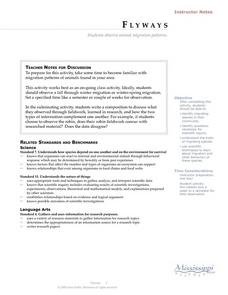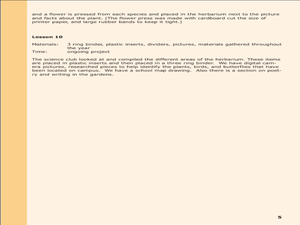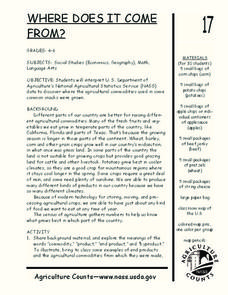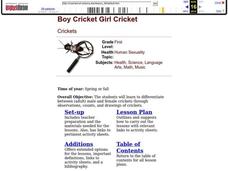Curated OER
Watercolor Butterfly
Students identify and analyze the anatomy of an insect and create a watercolor butterfly. They identify the three body parts of a butterfly by pointing to them on the butterfly they have created and demonstrate the splatter paint...
Curated OER
Good Habits Grow in Room 3
Students go out on a limb with these ideas for using a tree to recognize good behavior, celebrate holidays, and build skills. They recognize and celebrate the positive behavior of their peers.
Curated OER
Migration Activation
Young scholars play the role of migrating birds. As a class, they simulate a migration of birds to one place and back again. They relate their habitat size and changes to their current population numbers. They discover the many dangers...
Curated OER
Mother Nature Has Her Say
Students use their creative writing skills to develop interview questions for Mother Nature. Using writing, they respond to the questions another student developed and use the internet to research any topic they need more information on....
Curated OER
Tree Cookies
Students identify heartwood, sapwood, and a tree's annual rings, infer from a tree's rings what damage or stress might have occurred in its life, and make a time-line of human history that coincides with a tree's rings.
Curated OER
Puffin Patrol
Bird diversity and the majestic puffin are the topics of today's lesson. Children discuss and look at images of puffins, and then they use felt to put a puffin body together. After that they talk about what and how puffins eat. They get...
Curated OER
Where Does It Come From?
Students explore where agricultural commodities used in snack foods are grown. They choose a snack food and locate the top five states that produce the food that the snack is made from.
Curated OER
Immigration Debate
Students investigate the law recently passed in Arizona, "Support our Law Enforcement and Safe Neighborhoods Act." In this history lesson, students watch a video on immigration then work in small groups to prepare a debate on the...
Curated OER
The Battle for Congress: Midterm Elections 2010
Students research midterm elections. In this United States Congress lesson, students use the Internet to explore the issues, candidates, platforms and stakes of the midterm elections of 2010. This extensive lesson makes use of...
Peace Corps
Weather and Water in Ghana
Students investigate the climate of their region. Students research statistics and conduct interviews. Students take a virtual tour of Ghana and discuss its climate. Students consider water conservation and the role it plays in both...
Curated OER
Sneetches by Dr. Seuss:
Students enter the classroom, half of them are given die-cut stars. They are told to keep the star for later. At the start of the day, the students with stars a piece of candy. Students brainstorm how it feels to get/not get a piece...
Curated OER
Animal Migratory patterns
Students use field research and traditional research to identify migrating species of birds as well as their migratory patterns. Students generate a list of questions regarding migration and a plan to research the questions. A field...
Curated OER
Plant Systems
Second graders learn about plant systems and how plants grow and function. In this plant lesson plan, 2nd graders collect data based on roots, leaves, terrariums, plant uses, and locations of certain kinds of plants. They fill out...
Curated OER
Changing Perspectives on the Japanese Internment Experience
Learners explore the issue of Japanese-American internment. In this World War II lesson, students analyze historical biases regarding Japanese-American internment as they analyze literature, research print and Internet sources, and...
Curated OER
How Plants Help Us Breathe
Third graders discuss how humans breathe and how plants help us to stay alive. In groups, they identify and label the different parts of plants and describe their functions. They compare and contrast the ways plants and animals breathe...
Curated OER
Arthropods at Home- Spider, Isopod, or Any Arthropod
Students design a habitat for an arthropod. In this organisms lesson, students read the book, A House is a House For Me. Students find an arthropod and create a terrarium.
Curated OER
Nature Oriented Kindness Projects
Students complete various nature activities where they work together to create a butterfly garden, plant flowers, learn about nature survival, and more. In this nature lesson plan, students work together in groups and display kindness...
Curated OER
Where Does It Come from?
Young scholars read articles about various agricultural products and create a map using the statistics in the article. In this agricultural statistics instructional activity, students look at the geography of the country and which...
Curated OER
Head, Shoulders, Knees & Toes
Students, through observation of crickets, recognize and use proper names for human and insect body parts. They compare and contrast parts of human and insect body parts.
Curated OER
Boy Cricket Girl Cricket
First graders differentiate between (adult) male and female crickets through observations, counts, and drawings of crickets.
Curated OER
Chinese New Year: Lai-See Envelopes Lesson Plan
Students are introduced to the purpose behind the Chinese New Year celebration. As a class, they examine different traditions focusing on the Lai-See envelopes. After watching a PowerPoint presentation, they make their own envelopes...
Curated OER
Momentum
Students explore the concept of "transfer of momentum". In this physics lesson, students observe the results of two objects or people as they make contact in different ways. Students on roller blades and model cars of different weights...
Curated OER
Exploring the Night Sky: Fall/Winter
Students explain how moon phases occur. They explain three ways that the night sky has been used through history. Students locate some of the constellations in the night sky. They discuss stories and myths surrounding stars.
Curated OER
Dig In
Students explore harvest festivals. For this harvesting lesson, students view photos of Christian harvest festivals and Jewish harvest festivals. Students plan a harvest festival within their own school.


